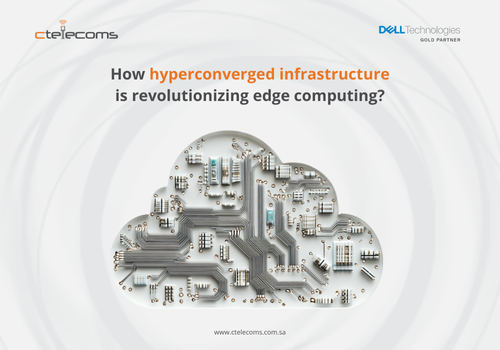

2025/04/13 Computing & Hyper-converged Infrastructure Solutions 41 visit(s) 2 min to read
Ctelecoms

Things are changing with how businesses use tech, especially when they have offices or even just need tech in different places – what we call "edge computing" and "distributed organizations.
Many people think this change is happening because the old methods for setting up IT were too expensive and not always as effective as hoped.
You know, even though everyone talks about how awesome "the cloud" is for making things flexible and efficient, it hasn't always been a perfect fit for everyone. Smaller companies sometimes get stuck with high cloud bills, don't have the tech experts on staff, and worry about security. And for bigger companies with lots of locations, it can be a headache to make sure everyone has a good internet connection, that their data is safe everywhere, and that their cloud stuff works with the systems they already have. That's where this thing called HCI can come in handy.
Cloud technology has advanced a lot, but it can still be hard for businesses of all sizes to handle and keep their data safe when it's not in one central place. Some companies have completely switched to the cloud, getting rid of their own on-site computers. But now, many of them are finding that their cloud contracts are costing a lot of money, the services aren't always reliable, and things can get slow. This slows down important processes that need to happen right away at those smaller, out-of-the-way locations.
Often, these companies have to decide if they want to be responsible for setting up and managing their own computers and software at these locations. While that might mean things are more reliable, it can be really expensive and complicated to do. Plus, these smaller sites, especially the "edge" ones, might not have a lot of extra room for big computer equipment. And finding tech people who know their stuff in those areas can be tough, which means paying more to bring in experts just adds to the costs.
Companies with many locations, like stores, factories, energy companies, and hospitals, have been struggling with "edge computing." These businesses need current data to make quick decisions, be efficient, and keep their businesses running smoothly. When the cloud is slow or unreliable at these locations, it causes problems.
The data they're getting at these remote locations is becoming more and more time-sensitive. They need to use AI right away to make decisions quickly. It just isn't fast enough to wait for data to go all the way to the cloud and back for AI to process. Businesses need reliable and affordable ways to process information quickly so they can give their customers the best and fastest service. That's why remote locations, or "edge sites," are becoming more important.
In fact, research from IDC shows that the world will spend an incredible $232 billion on edge computing by 2024. That's 15% more than last year! They think this will keep growing, reaching almost $350 billion by 2027. This shows how important this technology is becoming.
Putting in a full "HCI" system at these edge locations as part of your cloud plan can really make things run smoother. HCI is like putting all the computer parts – the brains, the network connections, and the storage – into one easy-to-manage setup. It's different from the old way of doing things, where you needed different special equipment for each part. Modern HCI uses some clever tricks with software to need fewer actual computers without losing performance. It's a smart way to get the same kind of powerful tech you'd find in a big office.
An HCI system can run your apps and keep your data safe at these remote locations. It can also connect to the cloud and your main office when needed. It's also flexible, so you can add pieces as needed. This is better than older systems that were often more powerful (and expensive) than necessary.
The latest HCI systems are designed specifically for smaller locations. They can connect easily with both the technology at the edge and the cloud or main office, even if they're set up differently.
These flexible and easy-to-manage setups only need two computers to be very reliable, instead of the usual three or more. This saves money without sacrificing reliability. If something goes wrong, it usually switches over to the backup in under 30 seconds, so your data stays safe and things keep running. Fewer computers also mean you don't need as much physical space, which is perfect for smaller locations.
Another great feature is how simple it is. The companies that make HCI have worked hard to make it less complicated. They've designed systems that are easy to set up and manage remotely. Regular IT people can usually handle the installation, so you don't need to hire expensive specialists. These systems can often be up and running in less than an hour, so you don't have a lot of downtime, and you can get new locations or applications working quickly.
So, HCI systems are a great option for doing computing at the edge. They work well with the cloud and the tech in your main office. They can handle the tough demands on businesses with many locations because they use resources efficiently and can be set up quickly in remote places.